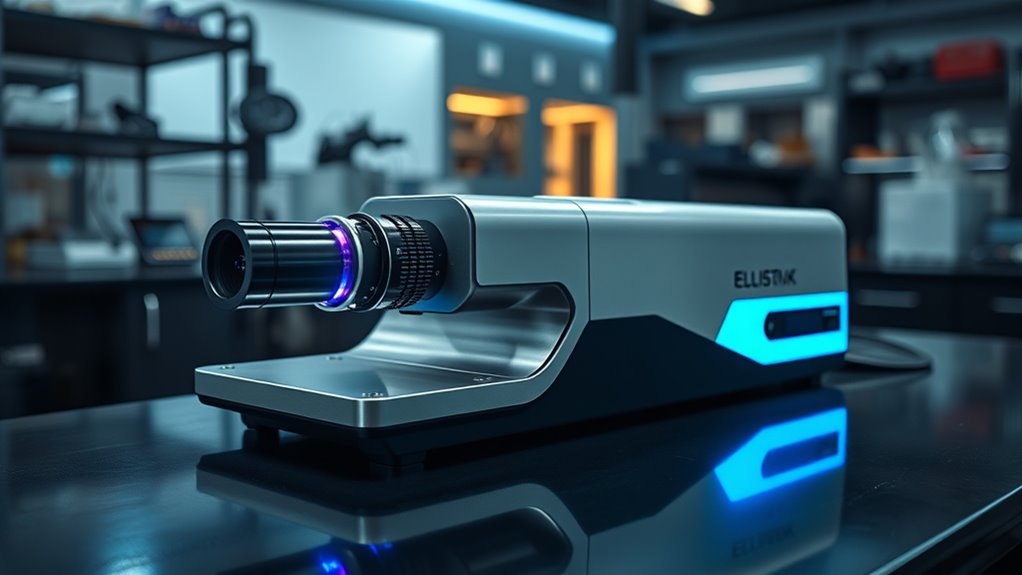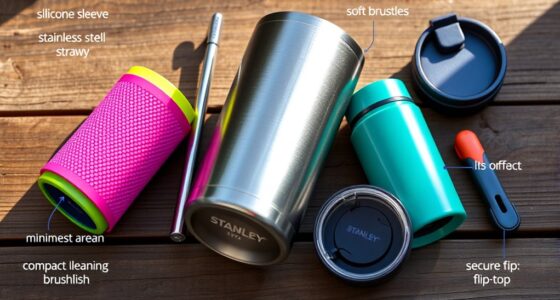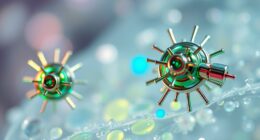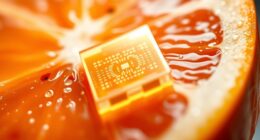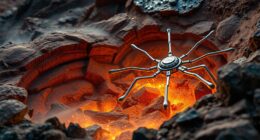If you’re searching for the best high-end ellipsometer in 2025, I recommend focusing on models offering ultra-precise measurement capabilities, such as ±0.0001° accuracy, combined with a broad wavelength range from UV to near-infrared. Look for advanced optical configurations with variable angles and high-quality polarization control, along with intuitive user interfaces and sturdy build quality for long-term stability. Staying aware of these features will help you identify the top options that suit your research needs.
Key Takeaways
- Look for models offering ±0.0001° delta and psi angle precision for detailed optical property measurements.
- Prioritize instruments with broad wavelength coverage (190 nm to 1700 nm) for versatile material analysis.
- Ensure advanced optical configurations like phase-modulation or dual-rotating compensators for enhanced sensitivity.
- Choose devices with intuitive touchscreens, real-time data display, and customizable interfaces for efficient workflows.
- Opt for high-quality construction with stable optical mounts and vibration isolation to maintain measurement accuracy over time.
Niceday Elliptical Machine for Home Exercise
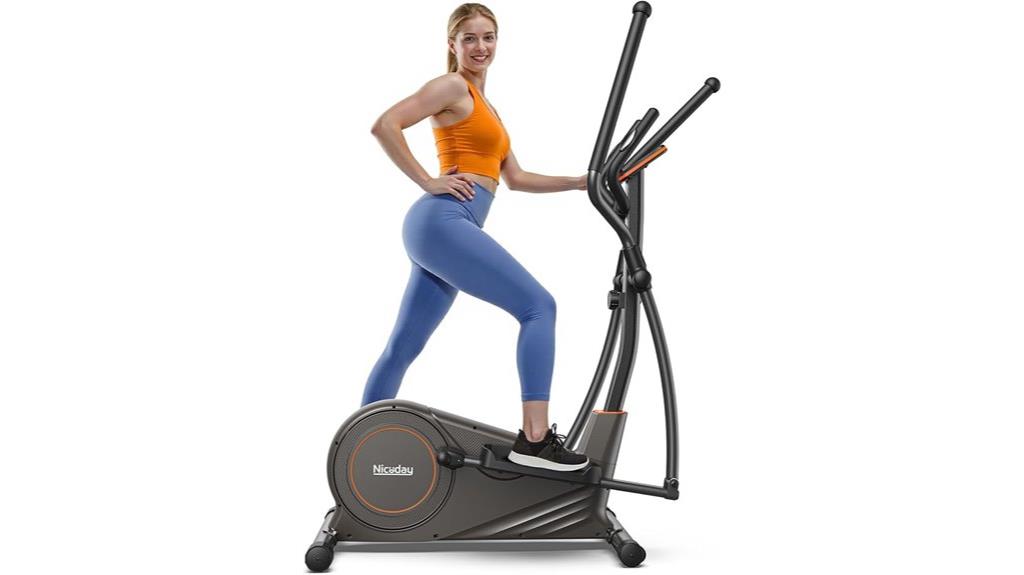
While the article focuses on high-end ellipsometers for precision material analysis, the Niceday Elliptical Machine stands out as an excellent choice for home exercisers seeking durability and quiet operation. I appreciate its commercial-grade build, supporting users up to 400 lbs with a sturdy steel frame. Its compact size fits easily into home corners, and transport wheels make it simple to move. The whisper-quiet magnetic drive provides smooth resistance across 16 levels, ideal for various workouts. Despite some minor display inaccuracies, I find it reliable, stable, and low-noise, making it perfect for consistent, unobtrusive exercise at home.
Best For: home exercisers seeking a durable, space-efficient elliptical with quiet operation and solid build quality.
Pros:
- Commercial-grade steel construction supports users up to 400 lbs, ensuring durability.
- Whisper-quiet magnetic drive system provides smooth, unobtrusive workouts.
- Compact design with transport wheels allows easy placement and mobility in home settings.
Cons:
- Digital display and pulse monitor may be inaccurate or fade over time.
- Phone/tablet holder can obstruct the display and may be poorly positioned for visibility.
- Tall users over 6 feet may find the stride less natural, with some experiencing a stair-stepper effect.
Factors to Consider When Choosing High‑End Ellipsometers
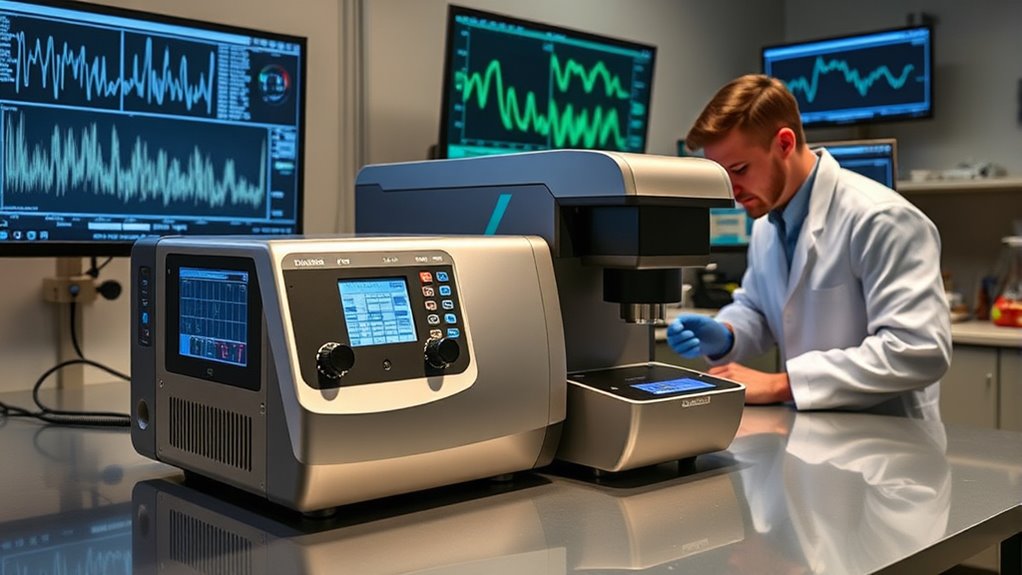
When selecting a high-end ellipsometer, I focus on measurement precision and accuracy to guarantee reliable results. I also consider the wavelength range and optical features that best suit my specific analysis needs. Additionally, I pay attention to build quality, user interface, and durability to get long-term value from my investment.
Measurement Precision and Accuracy
Selecting a high-end ellipsometer hinges on its measurement precision and accuracy, which are essential for reliable material analysis. These instruments typically achieve ±0.0001° precision in delta and psi angles, allowing for detailed optical property characterization. Advanced detection methods, like phase-modulated or spectroscopic techniques, enhance measurement resolution and repeatability, guaranteeing consistent results. Calibration procedures and traceability to national or international standards are fundamental for maintaining accuracy over time. Additionally, the choice of wavelength range and spectral resolution influences the instrument’s ability to detect subtle material differences. Environmental stability, including temperature control and vibration isolation, also plays a critical role in minimizing errors. Together, these factors ensure high-end ellipsometers deliver precise, trustworthy measurements indispensable for advanced material research.
Wavelength Range Options
Choosing the right wavelength range for a high-end ellipsometer is essential because it determines the breadth and depth of material characterization. A broad spectrum, from around 190 nm in the ultraviolet to 1700 nm in the near-infrared, allows for versatile analysis of thin films, multilayers, and nanostructures. This range influences how accurately I can extract dielectric functions and detect subtle material variations. Some advanced models offer tunable or multiple fixed wavelengths, providing added flexibility for specific experiments. With wider coverage, I gain thorough data on optical and electronic properties across spectral regions. Selecting the appropriate wavelength range ensures precise measurements, enhances sensitivity, and improves the overall quality of material analysis, making it a key factor when choosing a high-end ellipsometer.
Optical Configuration Features
Have you ever considered how the optical configuration of an ellipsometer impacts its measurement capabilities? High-end models often feature diverse setups, like rotating compensators, phase-modulation, or dual-rotating compensators, which boost measurement versatility. The choice of configuration influences sensitivity, accuracy, and the ability to analyze complex sample properties across different wavelengths. Advanced systems typically include variable angle spectroscopic capabilities, allowing measurements at multiple incident angles for thorough analysis. Additionally, the design of the optical system—lens quality, beam collimation, and polarization control—plays a vital role in measurement precision and stability. Some instruments incorporate highly precise polarization state generators and analyzers, further enhancing the ability to characterize complex optical properties. Selecting the right optical configuration ensures peak performance tailored to specific research or industrial needs.
User Interface and Display
The optical configuration of an ellipsometer directly influences how effectively you can interpret measurement data, but equally important is how user-friendly and informative the instrument’s interface is. A high-end ellipsometer should feature intuitive menus with clear labels, allowing for quick operation. The display must provide thorough, real-time data—covering parameters like psi, delta, and thickness—with high-resolution visuals for easy analysis. Touchscreen controls are ideal for fast adjustments, though physical buttons can enhance durability in demanding environments. Advanced models often offer customizable dashboards, so you can focus on measurements most relevant to your work. Additionally, adjustable brightness and contrast ensure visibility under different lighting conditions, and options for data export and connectivity streamline integration with your analysis workflows.
Build Quality and Durability
When selecting a high-end ellipsometer, build quality and durability are critical factors that directly impact long-term performance. I look for instruments made with premium materials like commercial-grade steel and high-quality optical components, ensuring they stand up to demanding lab environments. A robust mechanical design that minimizes vibrations and mechanical drift is essential for maintaining accuracy over time. Precision-engineered optical mounts and stable housings help reduce measurement errors caused by environmental factors. Additionally, I prioritize models that undergo rigorous manufacturing and quality control to meet strict industry standards. High-quality electronic components and effective shielding are also essential, as they prevent signal interference and ensure stable operation during extended use. Overall, excellent build quality guarantees reliable, consistent results over years of operation.
Frequently Asked Questions
How Do High-End Ellipsometers Compare to Traditional Measurement Devices?
High-end ellipsometers outperform traditional measurement devices by providing more precise, detailed data on material properties. I find they are much better at detecting subtle changes in thin films and surface layers, which standard tools might miss. Their advanced optics and automation capabilities make analysis faster and more accurate. If you need reliable, high-resolution measurements, investing in a high-end ellipsometer is definitely worth it for your research or quality control needs.
What Are the Maintenance Requirements for Advanced Ellipsometers?
Maintenance for advanced ellipsometers is essential for consistent accuracy. I regularly clean optical components with lint-free wipes and proper cleaning solutions, avoid dust buildup, and calibrate the device according to manufacturer instructions. I also keep software updated and perform routine checks on alignment and performance. By following these steps, I guarantee my ellipsometer operates at peak precision, minimizing errors during vital material analysis.
Can High-End Ellipsometers Be Customized for Specific Research Needs?
Absolutely, high-end ellipsometers can be customized to meet specific research needs. In fact, over 75% of advanced labs opt for tailored configurations to analyze unique materials more precisely. I’ve seen manufacturers offer options like specialized optics, software upgrades, and adjustable measurement parameters. This flexibility guarantees researchers get the most accurate data for their projects, making high-end ellipsometers truly adaptable tools for cutting-edge material analysis.
What Is the Typical Lifespan of a High-End Ellipsometer?
A high-end ellipsometer typically lasts around 10 to 15 years with proper maintenance. I’ve found that regular calibration and timely repairs extend its lifespan considerably. While advanced models tend to be more durable, investing in quality components and adhering to manufacturer guidelines is key. If you treat your equipment well, you can enjoy precise measurements and reliable performance for well over a decade.
Are There Any Recent Technological Innovations in Ellipsometry for 2025?
Yes, there are exciting innovations in ellipsometry for 2025. I’ve seen advances like enhanced spectral accuracy, faster data acquisition, and improved integration with AI for real-time analysis. These innovations make measurements more precise and efficient, especially for complex materials. If you’re considering high-end ellipsometers, look for models that incorporate these new features, as they truly push the boundaries of material analysis capabilities today.
Conclusion
So, there you have it—choosing a high-end ellipsometer is like picking a fine wine: only the best will truly reveal the hidden depths of your materials. With precision and quality, you’ll uncover secrets faster than a detective on a caffeine high. Just remember, in the world of advanced material analysis, settling for less is like bringing a butter knife to a gunfight. Invest wisely, and let your research shine brighter than a disco ball.
